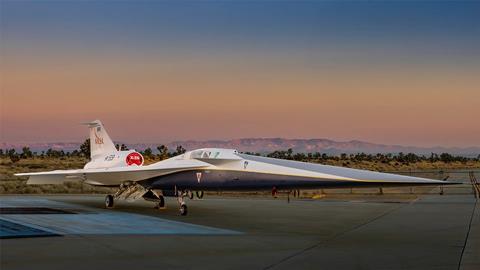With the drop of a curtain, NASA and Lockheed Martin on 12 January revealed the experimental X-59 aircraft that is intended to demonstrate the potential of “low-boom” supersonic flight.
During a roll-out ceremony at Lockheed’s Skunk Works facility in Palmdale, California, the sleek, single-engine jet was hailed by its developers as a potentially “revolutionary” step forward that could unlock commercial supersonic flights over populated areas.

“As we unveil this technological marvel, it’s really important to understand the profound impact the X-59 holds for the aviation industry,” says Pam Melroy, NASA’s deputy administrator. “Today, supersonic flight brings a thunderous boom. It is restricted across populated areas for good reason. And the X-59 is going to break that barrier.”
She adds that the X-59’s boom-dampening technology ”redefines the feasibility of commercial supersonic travel over land”.
The aircraft was assembled at Skunk Works and has been undergoing ground testing in a tent-like enclosure called a run stall. It has previously been seen publicly but appeared on 12 January with a fresh coat of paint.
NASA said the X-59’s first flight is “coming soon” but did not specify when the experimental aircraft will get airborne.
The development team used advanced manufacturing techniques including augmented reality, robotic drilling and modelling to help condense assembly time.
The aircraft is designed to produce a “soft thump” rather than a sonic boom, says Bob Pearce, associate administrator for NASA’s Aeronautics Research Mission Directorate.
“Is the thump quiet enough to allow supersonic flight over land? Our laboratory studies would say yes, but the real answer can be found engaging people who would hear it in daily life,” he says.
The flight-test programme with the X-59 is scheduled to last nine months. Then, the agency will begin a three-year period of measuring the aircraft’s sonic boom – including surveying members of the public about their perception from the ground as the aircraft flies over US cities.
Lockheed executives touted the commercial potential of the X-59’s technology, which could cut flight times between New York and Los Angeles roughly in half. John Clark, general manager of Skunk Works, says the technology could be in commercial use as soon as 2032.
”There is going to be a lot of opportunity in the future to drive new innovations with new commercial transport based on the technology we’re creating here,” he says.
The clean-sheet aircraft was assembled using components from various suppliers and off-the-shelf parts from Northrop Grumman T-38s, Boeing F-15s and F/A-18s, and Lockheed F-16s.
The demonstrator aircraft is powered by a single GE Aerospace F414-GE-100 and will be capable of cruising at speeds greater than 800kt (1,482km/h).
Notably, the aircraft lacks forward-facing cockpit windows, which were deemed too disruptive to airflow. Rather, pilots will rely on an external vision system based on ultra-high resolution cameras and screens.
Melroy says the system “has the potential to influence future aircraft designs, where the absence of that forward-facing window may prove advantageous for engineering reasons as it did for us”.
Other design features include a top-mounted engine “with a deck under the nozzle, which ensures that shock waves don’t merge behind the aircraft and create that disruptive shock below”, she says.
The aircraft’s unveiling marks a major milestone in the repeatedly delayed programme, as NASA previously intended to fly the X-59 in 2021. Most recently, the partners discovered a flight control problem during ground-testing that forced the aircraft back indoors for re-evaluation.


























